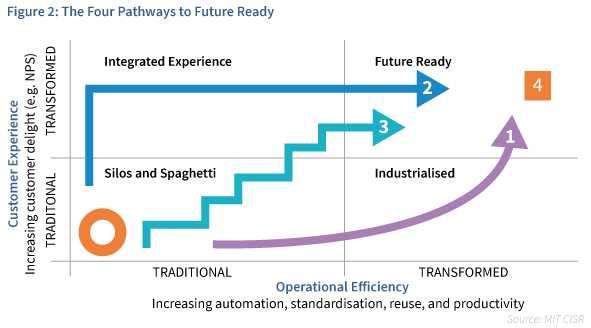SIX STEPS FOR CHARTING A PATH TOWARDS DIGITAL TRANSFORMATION

In today’s fast-paced digital environment, formulating a comprehensive transformation strategy is crucial. This strategy should encompass the integration of digital technology across all aspects of your business, fundamentally reshaping how you operate and provide value to customers. Below, we’ll outline six vital steps that organizations should take as they look to enhance their digital maturity.
Step One: Define Your Digital Vision
Start by creating a compelling vision of what digital transformation signifies for your company. For instance, if you’re in the healthcare industry, you may envision leveraging telehealth platforms, wearable technologies, and remote patient monitoring to provide personalized and readily available healthcare services. It’s essential that this vision aligns with your broad business objectives and is communicated effectively throughout your organization.
Step Two: Identify Your Path to Digital Readiness
Next, you must identify which digital transformation strategy best suits your organization. Research from the MIT Center for Information Systems (MIT CISR) has highlighted four unique approaches to becoming ‘Future Ready�’:

1. Operational Efficiency: This strategy aims to reduce costs and enhance the efficiency of business processes by digitizing existing procedures. It results in lower operational costs and enhanced process speed and quality. However, it may limit innovation potential and could risk commoditization if competitors also achieve similar efficiencies.
2. Customer Experience: This strategy emphasizes utilizing digital technologies to improve customer interactions, aiming to deepen relationships and heighten customer satisfaction. It can lead to improved customer loyalty, possibly increasing customer lifetime value, and stronger brand differentiation. However, it may also lead to increased customer expectations and challenges in quantifying the return on investment.
3. Product/Service Digitization: This strategy involves developing new digital products or services or enhancing existing ones with digital components. It offers the potential for new revenue streams, market differentiation, and opportunities to drive customer engagement and data collection. However, it also comes with a high level of risk and investment and the potential cannibalization of existing product/service lines.
4. Business Model Transformation: This ambitious strategy involves a total transformation of the existing business model using digital technologies. It presents the potential for significant competitive advantages, market disruption, and access to new markets or customer segments. However, it is high risk due to the scale of transformation required and may encounter significant internal resistance to change.
Remember, these pathways are not exclusive; many organizations follow more than one simultaneously. The key is to select the strategy or mix of strategies that best aligns with your organization’s strategic objectives, market position, and capabilities.
Step Three: Understand the Digital Customer
The subsequent step is to gain a thorough understanding of your customers’ evolving needs in the digital era. Perform market research and engage with your customers to discover their pain points and desires. For instance, as a retailer, understanding your customers’ demand for seamless mobile shopping experiences will guide your investments in responsive web design and mobile apps.
Step Four: Align Technology with Business Goals
Identifying the technologies that dovetail with your business goals and customer needs is a must. Consider adopting cloud computing solutions for improved scalability and flexibility, employing AI-driven chatbots to offer immediate customer support and enhance response times, or using big data analytics to gain insights into customer behavior and make data-driven decisions. Whichever path you take, it’s crucial that these technology decisions closely align with your business strategy.
Step Five: Foster a Digital Culture
Embracing a digital culture is as important as technological advancement. Cultivate a culture of continuous learning and innovation through training programs, hackathons, and cross-functional collaborations. Encourage your team to adopt new technologies and experiment with innovative ideas.
Step Six: Embrace Continuous Transformation
It’s vital to remember that digital transformation is not a one-time project, but an ongoing journey of evolution and adaptation. Consistently review and tweak your strategy in response to market fluctuations, technological progress, and customer feedback. Stay abreast of emerging trends and evolving customer preferences.
Devising a successful digital transformation strategy demands a clear vision, a customer-centric approach, an appropriate technology selection, a cultural shift, and continuous evaluation and refinement.
AHEAD accelerates the impact of technology on business; contact us today to propel your digital transformation forward.

 ;
; ;
; ;
;